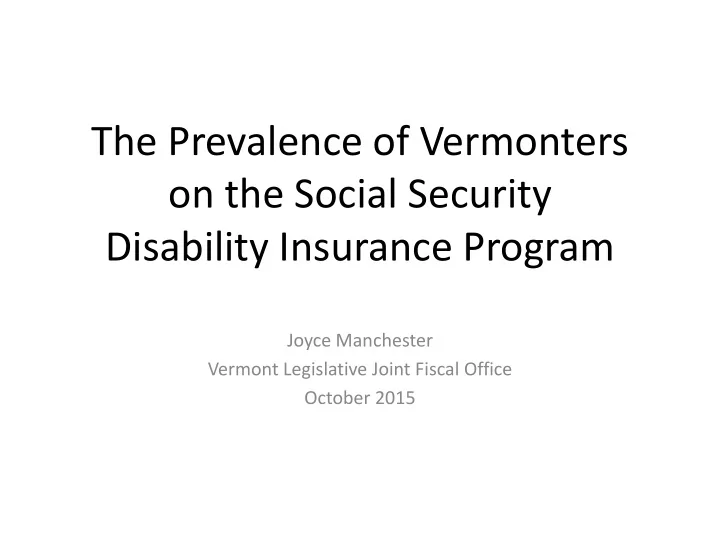

The Prevalence of Vermonters on the Social Security Disability Insurance Program Joyce Manchester Vermont Legislative Joint Fiscal Office October 2015
The Prevalence Rate • Compare number of beneficiaries in an age group and state to the number of state residents in that same age group • Look only at disabled worker beneficiaries – Receive benefit based on their own work history • Data sources – Annual Statistical Report on the Social Security Disability Insurance Program, 2013; – U.S. Census Bureau, Annual Estimates of the Resident Population, July 2013 2
Findings • In 2013, Vermont ranked #13 among the states for the share of adults < age 66 on SSDI • Vermont ranked #2 for SSDI prevalence in the age group under 35 (NH #1, ME #3) • From 2000 to 2013, the share of people in Vermont on SSDI rose – almost 4 times as fast as the increase in the national average, under age 35 and ages 35-44 – almost twice as fast as the increase in the national average, ages 45-54 3
Figure 1. SSDI Prevalence as Share of Resident Population, 2013 VT ME NH US 13.16% 11.28% 10.69% 10.72% 8.59% 6.79% 6.65% 5.49% 5.25% 4.19% 4.12% 2.50% 2.31% 2.12% 2.05% 0.90% Under 35 35-44 45-54 55-65 Sources: Annual Statistical Report on the Social Security Disability Insurance Program, 2013; Annual Estimates of the Resident Population, April 1, 2010 to July 1, 2013, U.S. Census Bureau . 4
0.0% 0.5% 1.0% 1.5% 2.0% 2.5% NH VT ME AR AL MA RI KY Appendix Figure 2. SSDI Prevalence Under Age 35, 2013 WV WI MI MO OH PA NM MN LA ID IA OK MT MS IN KS SD TN WY CT NE US OR WA MD NC SC DE FL VA IL NY TX ND GA NJ AZ UT CO AK NV DC CA 5 HI
Figure 2. Increase in SSDI Prevalence in ppts, 2000-2013 VT ME NH US 2.94% 2.88% 2.86% 2.79% 2.72% 2.34% 2.10% 1.86% 1.74% 1.58% 1.41% 1.27% 0.99% 0.49% 0.43% 0.23% Under 35 35-44 45-54 55-65 Sources: Annual Statistical Report on the Social Security Disability Insurance Program, 2000, 2013; Annual Estimates of the Resident Population, April 1, 2000 to July 1, 2010 and April 1, 2010 to July 1, 2013, U.S. Census Bureau. 6
Figure 3. Changes in Population and SSDI Prevalence, 2000 - 2013 VT Pop. VT SSDI ME Pop. ME SSDI NH Pop. NH SSDI US Pop. US SSDI 124.77% 88.68% 48.25% 31.90% 31.52% 16.19% 11.19% 11.01% 7.76% 0.76% 0.91% 0.13% Under 35 35-44 -10.44% -25.70% -26.75% -28.24% Sources: Annual Statistical Report on the Social Security Disability Insurance Program, 2000, 2013; Annual Estimates of the Resident Population, April 1, 2000 to July 1, 2010 and April 1, 2010 to July 1, 2013, U.S. Census Bureau. 7
Why might Vermont have such high and rapidly rising rates? • Reasons are unclear; here are four possibilities – Pro-active efforts by state agencies to enroll young people in the SSDI program – Out-migration of able-bodied young people, likely related to job opportunities – Rising opiate addiction – Relatively high rates of health insurance 8
9
Figure 6. SSDI Diagnosis As Mental Disorder (Total), and by Type of Opiate-Related Disorders, per 100,000, 2013 VT (per 100,000) ME (per 100,000) NH (per 100,000) US (per 100,000) 3683 3408 3185 1900 1510 1437 1196 821 802 738 637 350 346 329 306 304 275 263 211 184 Total Mood disorders Organic mental disorders Schizophrenic and other Other psychotic disorders Sources: Annual Statistical Report on the Social Security Disability Insurance Program, 2013; Annual Estimates of the Resident Population, April 1, 2010 to July 1, 2013, U.S. Census Bureau. 10
NOT caused by worse health or worse economic performance • 2013 American Community Survey reports proportion of working-age adults with self- reported disabilities – Maine 9 th – Vermont 21 st – New Hampshire 36 th • Real per capita growth in GDP, 2000-2013 – Only Maine has lower growth than the U.S. average (see Figure 5) 11
Figure 5. Per Capita Average Annual Real GDP Growth, 2000 to 2013 U.S. N.E. ME NH VT 1.3 1.0 0.8 0.7 0.4 U.S. N.E. ME NH VT Source: Bureau of Economic Analysis 12
Findings Imply Both Positive and Negative Aspects • On the positive side, – SSDI pays more than SSI – SSDI provides better health benefits than SSI – SSDI saves state dollars • On the negative side, – Loss of productivity in the workforce – State potentially loses tax dollars, short- and long-term – Risks in weak funding of SSDI trust fund and Medicare trust fund • SSDI may be the right path for some, but perhaps not best for everyone now on the rolls 13
Recommend
More recommend